Fresh chili is a valuable agricultural product but also highly perishable if not stored properly. In chili export—especially fresh chili—mastering effective preservation techniques is essential. It directly determines the product’s quality upon reaching international consumers and significantly impacts the exporter’s reputation.
At VIOT Minh Trang, we understand the critical importance of proper storage. Let’s explore the significance, preservation methods, and key considerations to ensure fresh chili meets export standards and maintains premium quality throughout the supply chain.
The Importance of Proper Fresh Chili Preservation in Export
Proper preservation of fresh chili plays a vital role in ensuring the success of the export process, bringing several essential benefits:
Maintaining Quality, Color, Flavor, and Spiciness
Effective storage helps fresh chili retain key sensory characteristics such as vibrant color, crisp texture, distinctive flavor, and the desired level of spiciness — all of which are highly valued by international markets.
Ensuring Food Safety and Hygiene
A standardized preservation process limits the growth of harmful microorganisms and minimizes the risk of contamination. This ensures food safety and hygiene, allowing the product to meet strict agricultural export requirements and the rigorous standards of demanding international markets
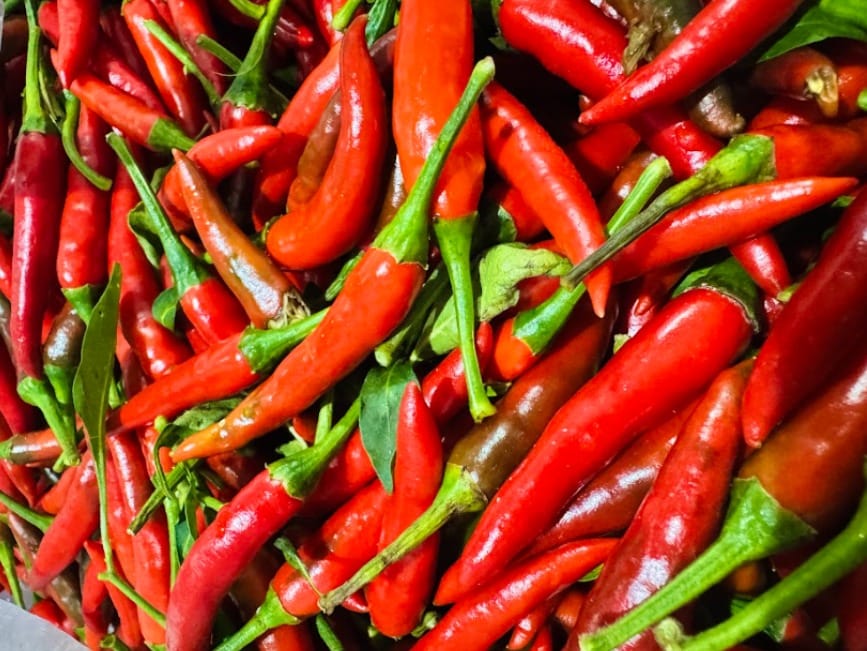
Ensuring Food Safety and Hygiene
Extending Shelf Life and Enabling Long-Distance Transport
Fresh chili has a naturally short shelf life. Appropriate preservation methods can significantly extend its “lifespan,” allowing for safe transportation to distant markets and overcoming logistics challenges. Under optimal conditions (10–12°C), chili can be preserved for 3–4 weeks.
Minimizing Damage and Loss
Proper handling and storage minimize bruising, rotting, and wilting during harvesting, pre-processing, packaging, and shipping. This substantially reduces product loss, enhancing economic efficiency for exporters.
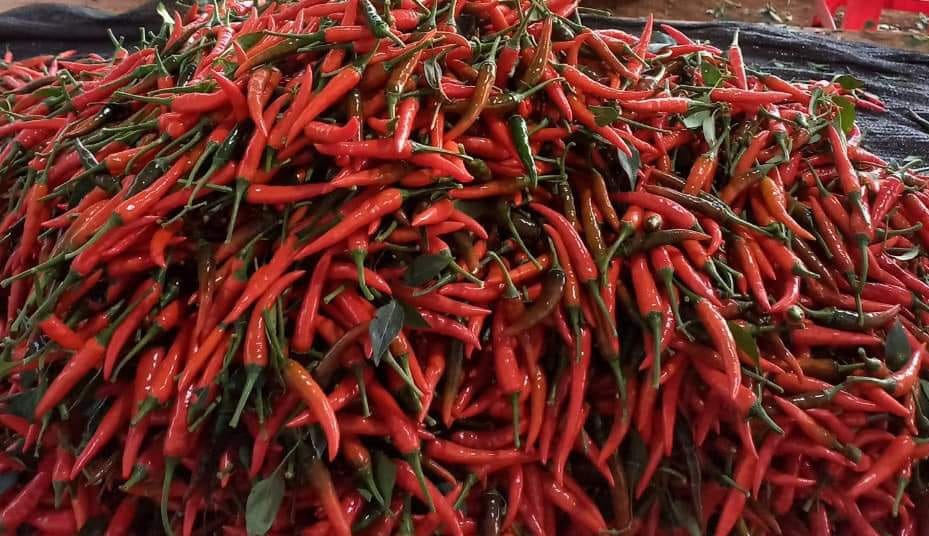
Minimize damage rate, fail-safe
See now:
VIOT Minh Trang – Vietnam’s chili export business
Common Methods for Preserving Fresh Chili for Export
There are How to preserve fresh chili for export, depending on the intended shelf life, market requirements, and specific handling conditions. These techniques are based on practical experience accumulated through the agricultural export process:
Cold Storage (Refrigeration)
This is the most commonly used method for extending the shelf life of fresh chili.
- Principle: Lowering the temperature slows down the chili’s respiration rate, inhibits the growth of microorganisms, and reduces enzymatic reactions that lead to spoilage.
- Application: Fresh chili is stored in cold rooms, refrigerators, or refrigerated containers at suitable temperatures (typically around 7–10°C, depending on the chili variety) and high relative humidity (90–95%) to prevent dehydration and wilting.
Specialized Packaging Preservation
- Modified Atmosphere Packaging (MAP):
This method uses bags or films that can regulate the levels of oxygen, carbon dioxide, and nitrogen inside the packaging. By lowering oxygen and increasing carbon dioxide, the respiration rate of the chili is reduced, significantly extending shelf life.
- Vacuum Packaging:
Air is completely removed from the packaging, creating a vacuum environment. This prevents the growth of aerobic bacteria and helps maintain the chili’s freshness and firmness during storage and transport.
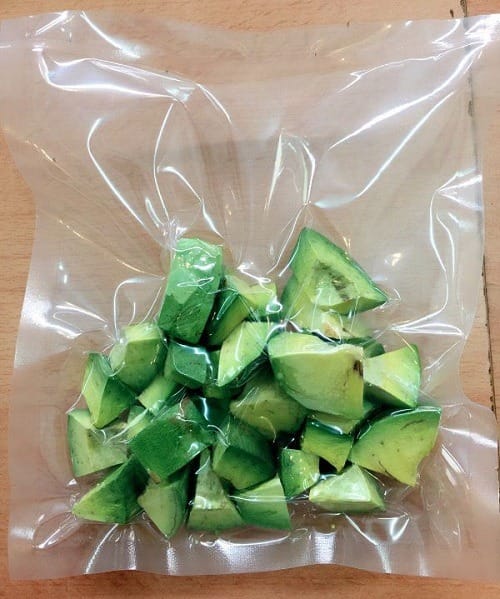
Specialized Packaging Preservation
Pre-Treatment Before Storage
- Washing and Surface Drying:
Remove dirt, impurities, and microorganisms from the surface of the chili. Ensure the chili is completely dry before storage to prevent mold growth. - Mild Heat Treatment:
Some pre-treatment methods, such as quick hot water dipping, can reduce microbial load and slow down the aging process. - Ozone or Safe Antimicrobial Solution Treatment:
For certain chili varieties, applying ozone or food-safe disinfectant solutions helps reduce surface bacteria. However, these methods must strictly comply with food safety regulations.
Frozen Storage (For Further Processing Purposes)
- Individual Quick Freezing (IQF):
Chili is rapidly frozen at extremely low temperatures (−35°C to −40°C), forming tiny ice crystals that do not damage the cell structure. - Advantages:
IQF preserves the chili’s color, flavor, nutrients, and texture almost perfectly for an extended period—ranging from several months to over a year. - Disadvantages:
High investment and operational costs, along with the need for an uninterrupted cold chain. This method is typically used for chili destined for further processing, rather than for direct fresh chili export.
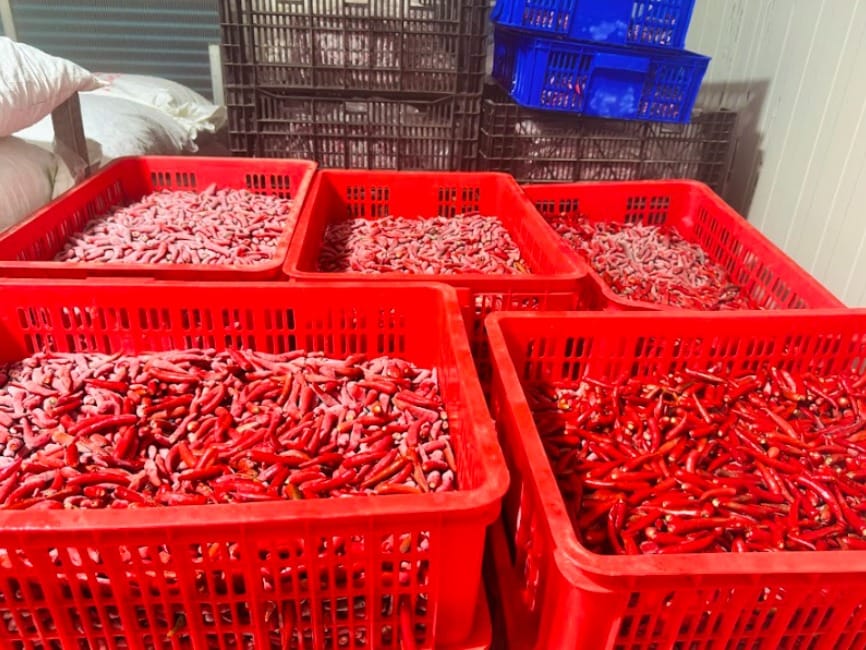
Store frozen
See now:
Export Standards for Dried Chili Peppers: Meeting International Quality Requirements
Step-by-Step Guide to Preserving Fresh Chili for Export
To optimize the quality of fresh chili for export, the following steps should be carefully followed:
Careful Harvesting and Sorting
- Harvest Timing: Pick chili at its optimal ripeness—not too green, not overly ripe—and avoid harvesting under intense sunlight to reduce heat stress.
- Proper Harvesting Technique: Gently pick the chili by hand to avoid bruising or breaking the stem.
- Sorting: Immediately remove any chili that is diseased, damaged, bruised, or scratched. Sort the chili by size and color to ensure consistency within each batch.
Initial Pre-Processing
- Cleaning: Gently wash the chili under clean running water to remove dust, soil, and surface contaminants.
- Drying: Allow the chili to air-dry completely on racks or use fans to dry the surface thoroughly. Ensure there is no moisture remaining before packaging to prevent mold growth.
- Optional Pre-Treatment: Apply light pre-treatment such as a quick dip in hot water (about 50–55°C) for a few seconds. This helps reduce microbial load and extend shelf life without affecting quality.
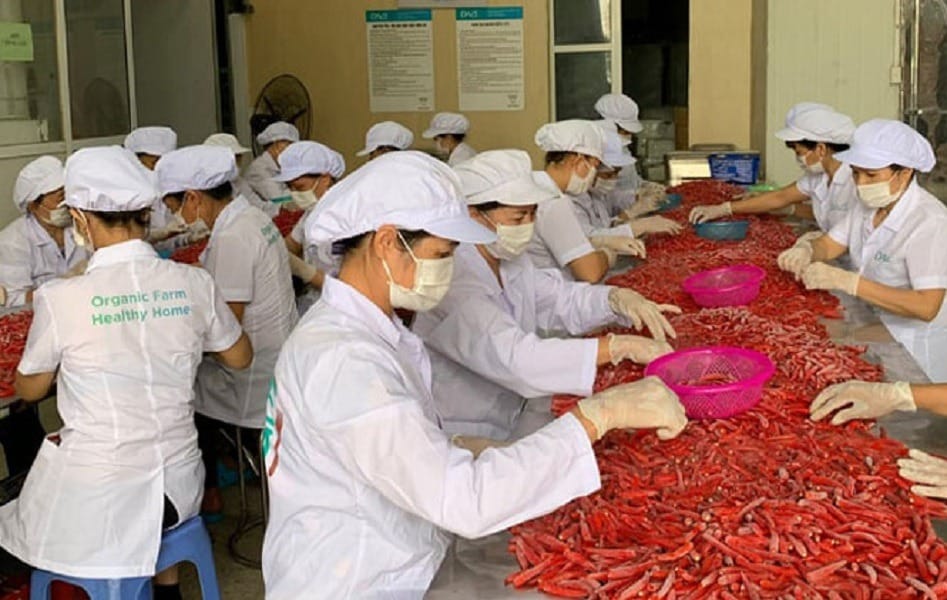
Initial processing
Rapid Cooling (Pre-Cooling)
After pre-processing, chili should be quickly cooled to the optimal storage temperature—typically around 7–10°C—to slow down respiration. This step is critical for extending shelf life and maintaining quality during storage and transport.
Proper Packaging
- Ventilated Packaging: Use packaging materials that allow for good airflow, such as ventilated cardboard boxes or mesh bags.
- Modified Atmosphere Packaging (MAP): For long-distance exports, MAP can be considered to help regulate the internal gas environment, slowing spoilage and preserving freshness.
- Careful Arrangement: Arrange the chili neatly without overpacking or compressing. This helps avoid bruising and allows air circulation. Packaging should be sturdy enough to protect the chili throughout the shipping process.
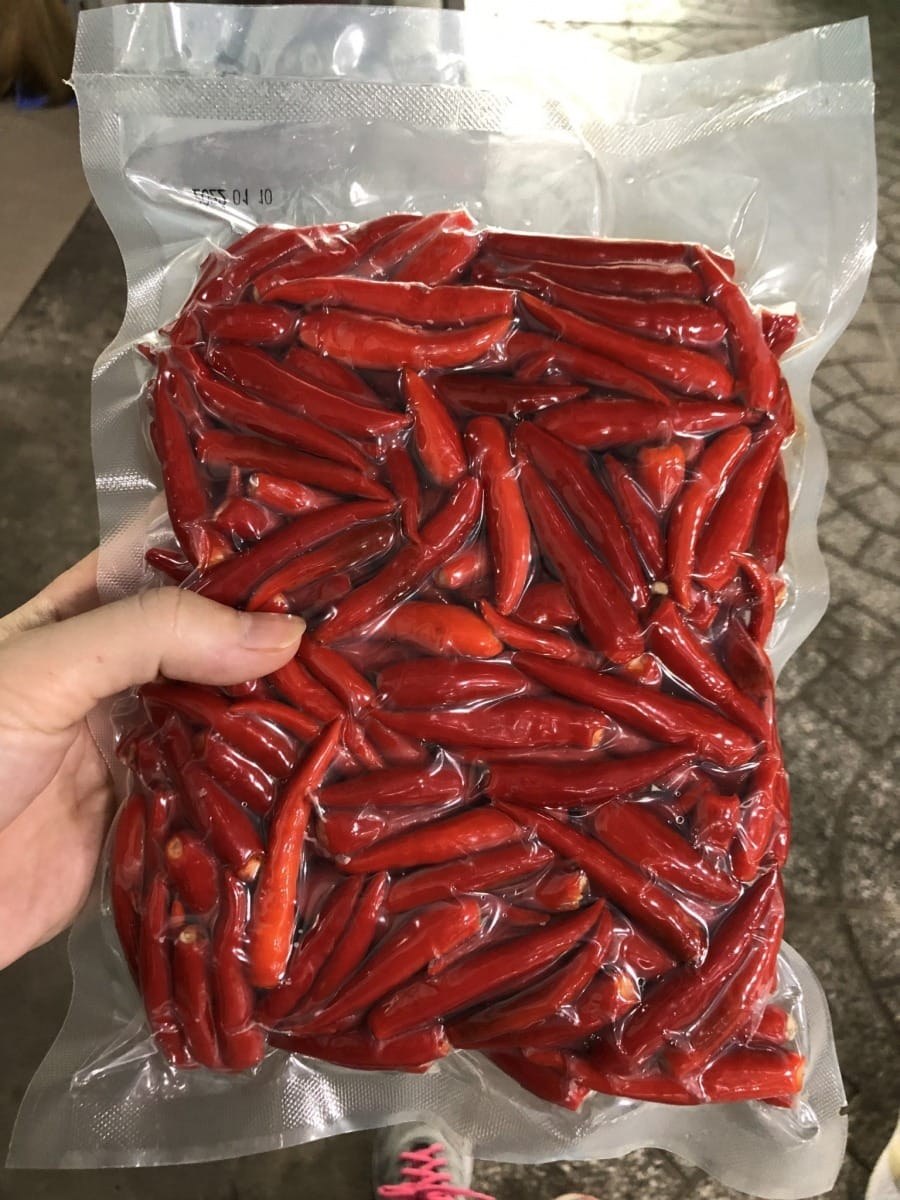
Suitable packaging
Cold Storage and Cold Chain Maintenance
- Temperature and Humidity Control: Maintain a stable temperature between 7–10°C and relative humidity of 90–95% in cold storage facilities to preserve freshness and prevent dehydration or spoilage.
- Uninterrupted Cold Chain: Ensure the cold chain remains unbroken from cold storage through transportation to port or airport handling. Any temperature fluctuation can significantly compromise the quality and shelf life of the chili.
Important Considerations for Transporting and Handling Fresh Chili for Export
The transportation and delivery process plays a crucial role in determining whether fresh chili retains its high quality and freshness upon reaching the importer. Strict compliance with regulations and the use of appropriate logistics measures are essential to prevent losses and maintain the exporter’s credibility.
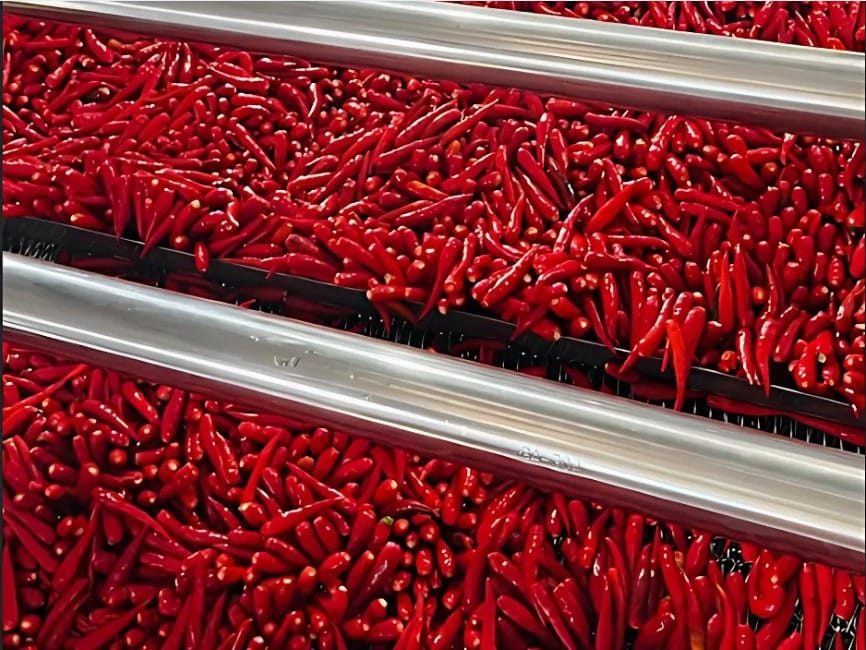
Key Considerations When Transporting and Handling Fresh Chili for Export
Temperature and Humidity Monitoring (Cold Chain)
Maintaining an unbroken cold chain is absolutely critical for fresh chili exports. Use temperature data loggers to continuously monitor conditions inside the container or transport vehicle throughout the journey.
Optimal Ventilation
Ensure that the container or transport vehicle has a proper ventilation system. Effective airflow removes ethylene gas (which accelerates ripening and aging) and excess moisture released by the chili. This prevents condensation buildup that can lead to mold growth and helps maintain even temperature distribution—crucial for preserving the freshness and quality of the chili during export.
Packaging and Cargo Arrangement
Goods must be arranged in a secure and organized manner to prevent shifting or collisions during transport. Use cushioning materials if necessary. Packaging must comply with the export packing standards of the destination market to ensure product integrity upon arrival.
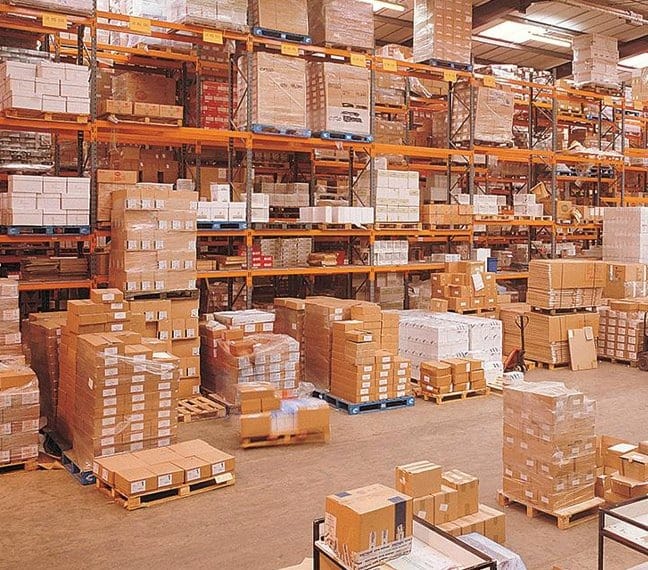
Packaging and Cargo Arrangement
Complete Documentation and Certifications
- Phytosanitary Certificate: This mandatory certificate confirms that the shipment is free from harmful pests and diseases. It is issued by the authorized plant quarantine agency in Vietnam.
- Certificate of Origin (C/O): This document proves the product’s origin, allowing importers to benefit from tariff preferences under trade agreements (e.g., EVFTA).
- Other Documents Required by the Importing Country: These may include pesticide residue test reports, microbiological safety checks, or other specific certifications as per destination market requirements
Compliance with Quarantine and Food Safety Regulations
Before exporting chili, it is essential to thoroughly understand the agricultural export standards of the target market—such as FDA and USDA requirements for the U.S., or the import rules of the EU, Japan, and South Korea. This ensures that shipments are not rejected or destroyed due to non-compliance.
See now:
Update the latest export chili price today
VIOT Minh Trang – A Leading Exporter of Premium Fresh Chili from Vietnam
VIOT Minh Trang is proud to be one of Vietnam’s pioneers in chili export, especially in delivering high-quality fresh chili through a professional and internationally compliant process. We are committed to providing products that meet global standards and satisfy the strictest market requirements.
We apply the most advanced fresh chili preservation methods—starting from strict quality control at our certified VietGAP/GlobalGAP farming regions, to modern cold storage systems and professional packaging processes.
Our uninterrupted cold chain ensures that VIOT Minh Trang’s fresh chili retains its freshness, vibrant color, flavor, and nutritional value throughout the entire transportation process.

VIOT Minh Trang – A Leading Exporter of High-Quality Fresh Chili
All of VIOT Minh Trang products are certified by strict international quality standards such as ISO 22000, HACCP, GMP, and Halal—demonstrating our strong commitment to food safety and hygiene. With years of experience and the capacity to supply in large volumes, we confidently meet all agricultural export procedures and standards required by the U.S. and other demanding markets, contributing to the increased value and reputation of Vietnamese chili export on the global stage.
Proper preservation of fresh chili for export is a key factor in ensuring product quality, safety, and competitiveness of Vietnamese agricultural goods in international markets. Investment in preservation technology, strict quality control from farming areas to logistics, and full compliance with import regulations are essential to helping Vietnamese fresh chili go further globally.
With continuous effort and dedication, companies like VIOT Minh Trang are helping to solidify the global presence and recognition of Vietnam’s agricultural exports.





Tác giả Tưởng Mạnh Biên
Là chuyên gia giàu kinh nghiệm trong lĩnh vực xuất khẩu nông sản. Với nhiều năm làm việc, nghiên cứu và trực tiếp tham gia vào các hoạt động sản xuất, kinh doanh và xuất khẩu nông sản, tác giả chia sẻ những kiến thức chuyên môn sâu sắc cùng các bài học thực tiễn giá trị nhằm hỗ trợ doanh nghiệp.
- Địa chỉ: Số 27, Tổ 23, Lĩnh Nam, Hoàng Mai, Hà Nội
- Email: viotvietnam.vn@gmail.com
- SĐT: 0977 728 269